当前位置:网站首页>[quick start of Digital IC Verification] 9. Finite state machine (FSM) necessary for Verilog RTL design
[quick start of Digital IC Verification] 9. Finite state machine (FSM) necessary for Verilog RTL design
2022-07-05 20:09:00 【luoganttcc】
Reading guide : The author has the honor to be a pioneer in the field of electronic information in China “ University of electronic technology ” During postgraduate study , Touch the cutting edge Numbers IC Verification knowledge , I heard something like Huawei Hisilicon 、 Tsinghua purple light 、 MediaTek technology And other top IC related enterprises in the industry , Pairs of numbers IC Verify some knowledge accumulation and learning experience . Want to get started for help IC Verified friends , After one or two thoughts , This column is specially opened , In order to spend the shortest time , Take the least detours , Most learned IC Verify technical knowledge .
List of articles
One 、 The basic theory
State machine Shorthand for FSM( Finite State Machine), Also known as synchronous finite state machine , We usually call it state machine for short , Reason why “ Sync ” Because all state jumps in the state machine are carried out under the action of the clock , and “ Co., LTD. ” It means that the number of States is limited . State machines are divided into two categories according to the reasons that affect the output , namely Moore State machine and Mealy State machine , What they have in common is : The jump of state is only related to input . The difference is mainly in the output : If the final output is only related to the current state and has nothing to do with the input, it is called Moore State machine ; If the final output is related not only to the current state but also to the input, it is called Mealy State machine . State machine is a very important application in sequential logic circuit , It is often used in large and complex systems .
Two 、 Automatic beverage vending machine
2.1、 Problem description
Design an automatic beverage machine , Set the price of drinks 2.5 element , You can use 5 Angular sum 1 Yuan coins , With change function .
notes : You can only cast at the same time 1 Yuan or 5 horn , You can't throw two at the same time .
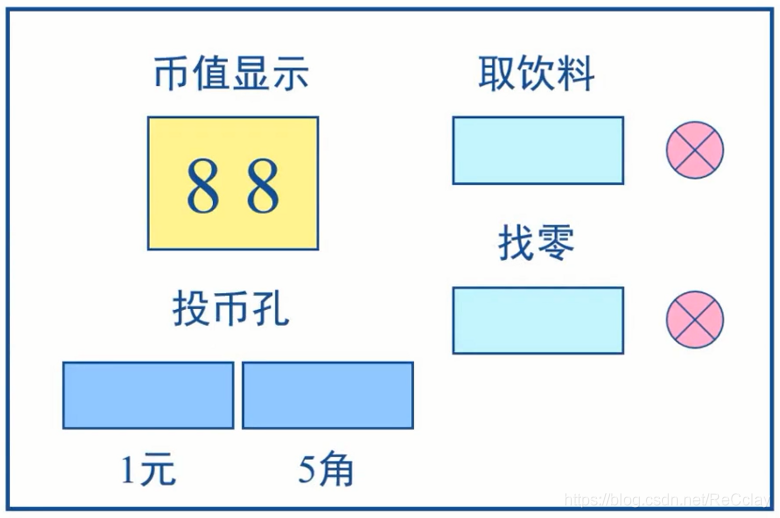
2.2、 Functional block diagram and interface definition
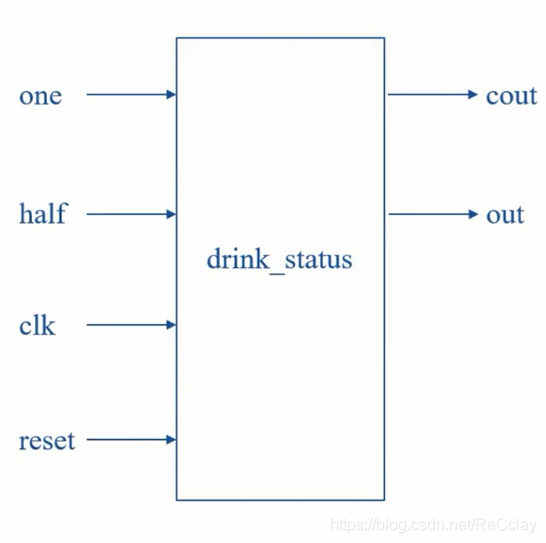
Interface signal definition
- clk: Clock input
- reset: System reset signal
- half: input 5 Dimes
- one: input 1 Yuan coins
- cout: Change signal
- out: The machine sells drinks
2.3、 State transition diagram - moore FSM
notes :Moore FSM characteristic : The output is only related to the current state , It has nothing to do with input !
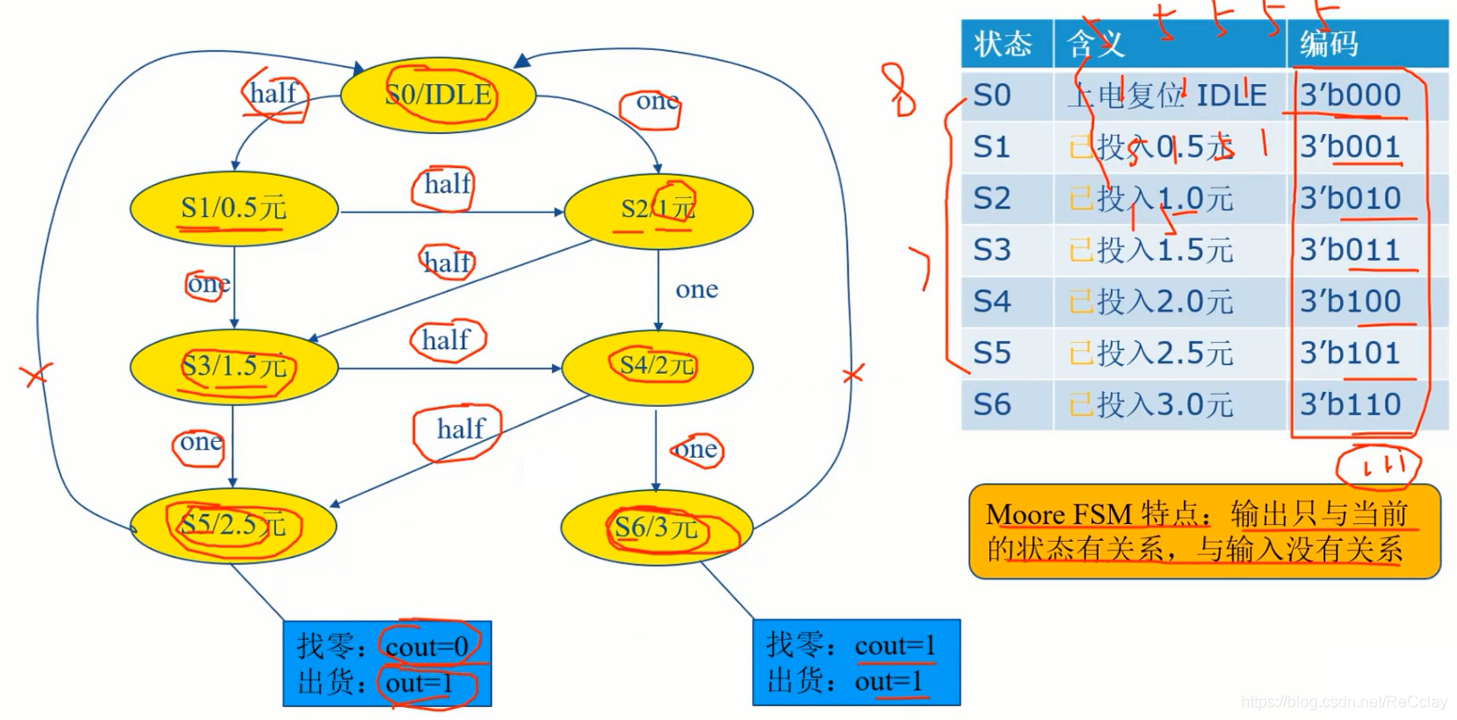
Moore FSM Of RTL Code
module drink_status_moore(
input wire clk,
input wire reset,
input wire half,
input wire one,
output wire out,
output wire cout
);
parameter [2:0] S0 = 3'b000,
S1 = 3'b001,
S2 = 3'b010,
S3 = 3'b011,
S4 = 3'b100,
S5 = 3'b101,
S6 = 3'b110;
reg [2:0] curr_state;
reg [2:0] next_state;
//first segment:state transfer
[email protected](posedge clk or negedge reset)
if(!reset)
curr_state <= S0;
else
curr_state <= next_state;
//second segment:transfer condition
[email protected](*)
case(curr_state)
S0 : if(half == 1'b1) next_state = S1;
else if(one == 1'b1) next_state = S2;
else next_state = S0;
S1 : if(half == 1'b1) next_state = S2;
else if(one == 1'b1) next_state = S3;
else next_state = S1;
S2 : if(half == 1'b1) next_state = S3;
else if(one == 1'b1) next_state = S4;
else next_state = S2;
S3 : if(half == 1'b1) next_state = S4;
else if(one == 1'b1) next_state = S5;
else next_state = S3;
S4 : if(half == 1'b1) next_state = S5;
else if(one == 1'b1) next_state = S6;
else next_state = S4;
S5 : next_state = S0;
S6 : next_state = S0;
default : next_state = S0;
endcase
//third segment:state output
//moore type FSM
assign out = ((curr_state == S5) || (curr_state == S6) ) ? 1'b1 : 1'b0;
assign cout = (curr_state == S6) ? 1'b1 : 1'b0;
endmodule
FSM Three paragraph writing :
- Good coding style
- Logic synthesis
- Readable stars
2.4、 State transition diagram - Mealy FSM
notes :Mealy FSM characteristic : The output is not only related to the current state , It is also related to input !
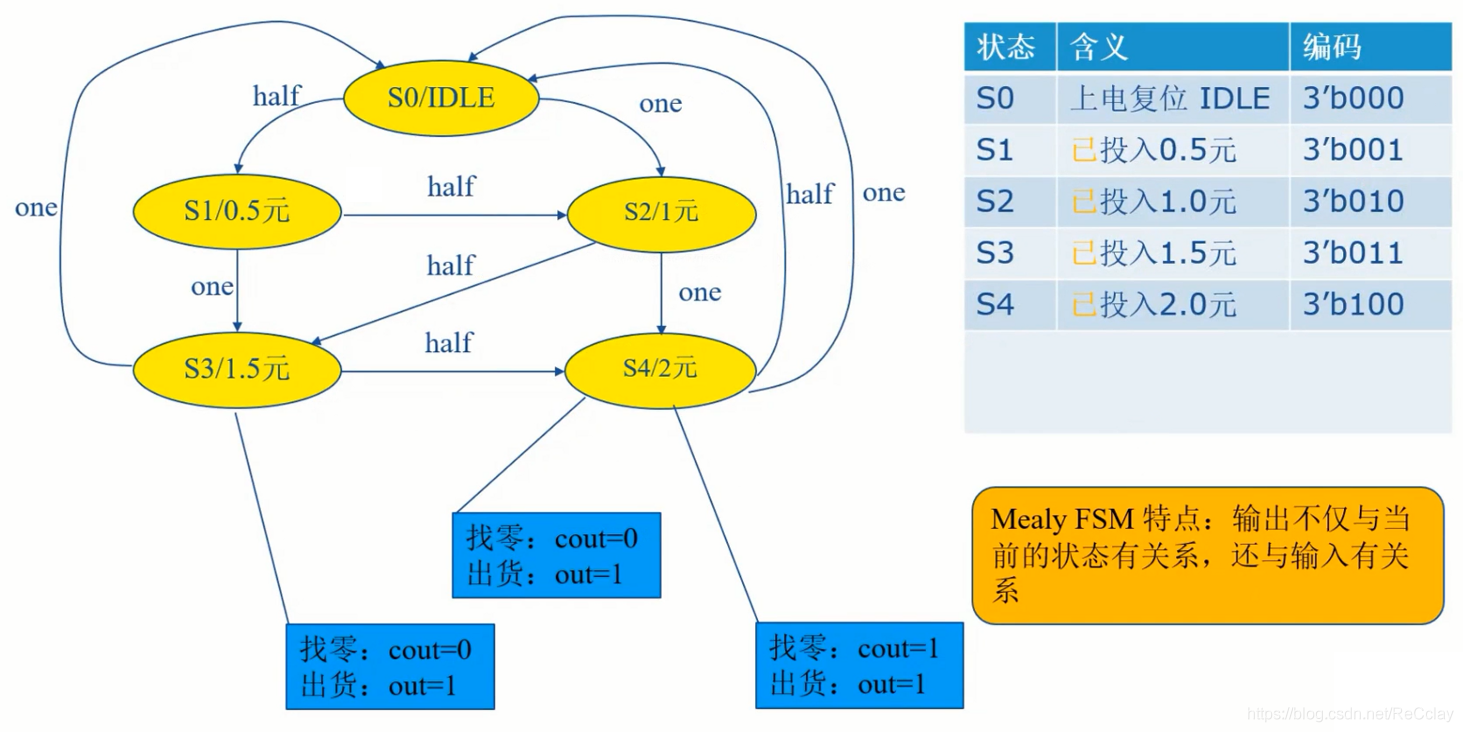
- Mealy It only took 5 States , But the output control will become complex !
Mealy FSM Of RTL Code
module drink_status_mealy(
input wire clk,
input wire reset,
input wire half,
input wire one,
output wire out,
output wire cout
);
parameter [2:0] S0 = 3'b000,
S1 = 3'b001,
S2 = 3'b010,
S3 = 3'b011,
S4 = 3'b100,
S5 = 3'b101,
S6 = 3'b110;
reg [2:0] curr_state;
reg [2:0] next_state;
//first segment:state transfer
[email protected](posedge clk or negedge reset)
if(!reset)
curr_state <= S0;
else
curr_state <= next_state;
//second segment:transfer condition
[email protected](*)
case(curr_state)
S0 : if(half == 1'b1) next_state = S1;
else if(one == 1'b1) next_state = S2;
else next_state = S0;
S1 : if(half == 1'b1) next_state = S2;
else if(one == 1'b1) next_state = S3;
else next_state = S1;
S2 : if(half == 1'b1) next_state = S3;
else if(one == 1'b1) next_state = S4;
else next_state = S2;
S3 : if(half == 1'b1) next_state = S4;
else if(one == 1'b1) next_state = S0;
else next_state = S3;
S4 : if(half == 1'b1) next_state = S0;
else if(one == 1'b1) next_state = S0;
else next_state = S4;
default : next_state = S0;
endcase
//third segment:state output
//mealy type FSM
assign out = ((curr_state == S3 && one == 1'b1) || (curr_state == S4 && (half==1'b1 || one==1'b1)) ) ? 1'b1 : 1'b0;
assign cout = (curr_state == S4 && one == 1'b1) ? 1'b1 : 1'b0;
endmodule
2.5、 Finite state machine circuit logic diagram
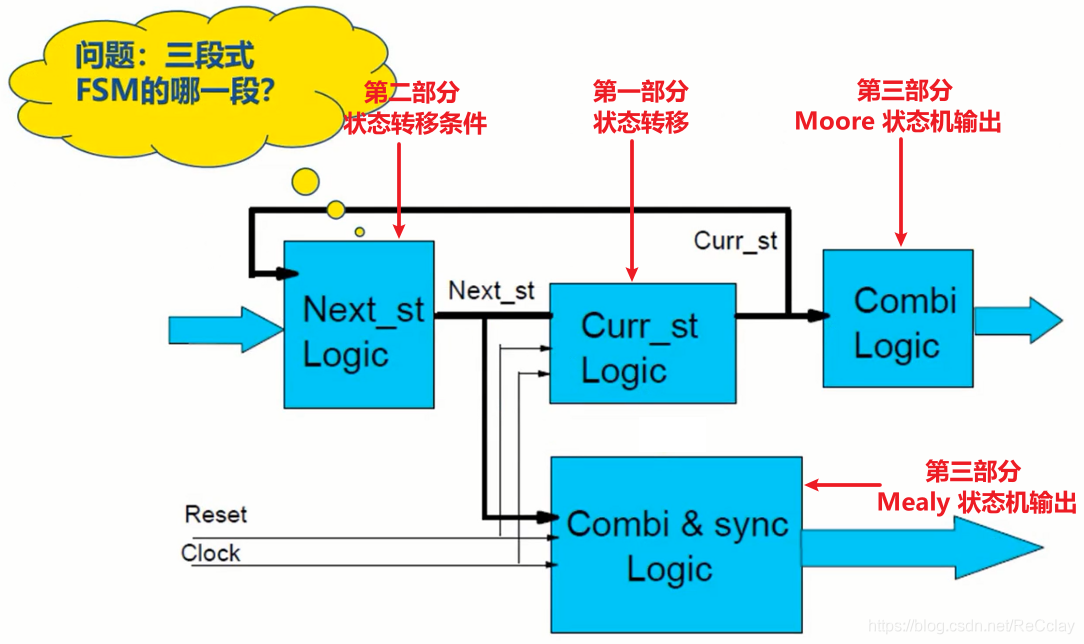
2.6、 Finite state machine summary
- FSM Design steps of finite state machine
- Interface definition
- State definition and coding
- Transition diagram of state
- According to the three segment coding style RTL Code
- To write TestBench Code
- Use Questasim Compile and simulate
- Check the input excitation through the waveform tool 、 Status signal and output signal
Frequently asked questions : Finite state machine classification ?
- answer :Moore State machine : The output of the state machine is only related to the current state
- Mealy State machine : The output of the state machine is not only related to the current state , Also related to the current input
Frequently asked questions : The difference between the two state machines ?
- answer :1、Moore State machine : After a finite gate delay of the clock pulse , The output is stable . The output will remain stable for a complete clock cycle , Even if the input signal changes within this clock , The output signal will not change . transport The influence of input on output can only be reflected in the next clock cycle . Separate input and output , yes Moore Important features of state machines .
- 2、Melay State machine : Because the output is directly affected by the input , The input can change at any time of the clock cycle , This makes the output state ratio Moore The output state of the state arrives one cycle in advance . The noise of the input signal may appear on the output signal .
- 3、 For the same circuit , Use Moore State machine design may be better than using Mealy The state machine has more States .
The key to state machine writing , Write in three parts :
- 1、 The first part is responsible for : State jump
- 2、 The second part is responsible for : Jump conditions
- 3、 The third part is responsible for : The output signal
2.7、 Something to be aware of :full case
- Define the complete state , Even some states may not appear in the circuit
- The purpose is to avoid the occurrence of Combinational logic ring
- Combinational logic rings can lead to STA There's no way to analyze ,DFT There is no way to cover
- Asynchronous timing (timing The path cannot be constrained , There is no way to analyze ) The problem of
3、 ... and 、 Actual test : Sequence detector
3.1、 Functional requirements of sequence detector
- The design requirements
- Design sequence detector with state machine (1110010)
- Design function
- Design a sequence detector , The sequence of detection is “1110010”
- When the input signal X In turn “1110010” when , The output signal Y Output a high level
- Otherwise, the output signal Y Low level
notes : Sequence detectors are often used in Engineering , be used for Detect sequence header !
3.2、 Timing diagram of timing detector

3.3、 State transition diagram of timing detector
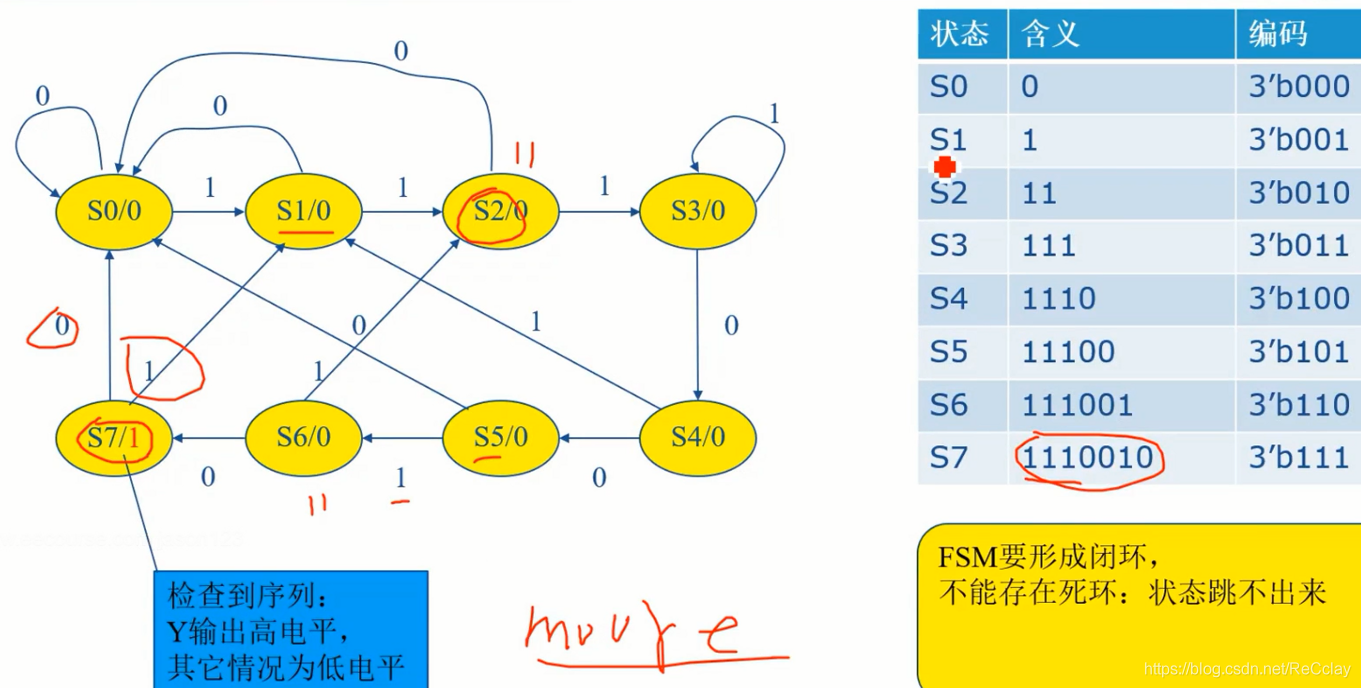
Look for the , The output is independent of the input , This is a Moore State machine !
3.4、 Reference code of sequence detector
RTL Reference code
// 1110010
module seq(
input wire in,
input wire clk,
input wire reset,
output wire out
);
parameter [2:0] S0 = 3'b000,
S1 = 3'b001,
S2 = 3'b010,
S3 = 3'b011,
S4 = 3'b100,
S5 = 3'b101,
S6 = 3'b110,
S7 = 3'b111;
reg [2:0] cur_state;
reg [2:0] next_state;
//first step: state transfer
[email protected](posedge clk or negedge reset)
if(~reset)
cur_state <= S0;
else
cur_state <= next_state;
//second: transfer condition
[email protected](*)
case(cur_state)
S0:begin
if(in == 1) next_state = S1;
else next_state = S0;
end
S1:begin
if(in == 1) next_state = S2;
else next_state = S0;
end
S2:begin
if(in == 1) next_state = S3;
else next_state = S0;
end
S3:begin
if(in == 0) next_state = S4;
else next_state = S3;
end
S4:begin
if(in == 0) next_state = S5;
else next_state = S1;
end
S5:begin
if(in == 1) next_state = S6;
else next_state = S0;
end
S6:begin
if(in == 0) next_state = S7;
else next_state = S2;
end
S7:begin
if(in == 0) next_state = S0;
else next_state = S1;
end
default: next_state = S0;
endcase
//third: output
assign out = (cur_state == S7) ? 1'b1 : 1'b0;
endmodule
TestBench Reference code
`timescale 1ns/1ns
module tb_led();
//reg define
reg clk;
reg rst_n;
reg C;
//wire define
wire Y;
// // Initialize the system clock 、 Global reset
initial begin
clk = 1'b1;
rst_n <= 1'b0;
#10
rst_n <= 1'b1;
end
always #5 clk = ~clk;
[email protected](posedge clk or negedge rst_n)
if(rst_n == 1'b0)
C <= 1'b0;
else
C <= {$random} % 2;
seq seq_inst(
.clk (clk ),
.reset (rst_n ),
.in (C ),
.out (Y )
);
endmodule
The selected simulation results are as follows :

Reference resources
- 《 Wildfire journey Altera EP4CE10 - State machine 》
- Combinational logic ring (Combinational Loop)
- State machine , Start with the details ( One stage 、 Two-stage type 、 Three paragraph ,moore type 、mealy type )
边栏推荐
- Debezium series: PostgreSQL loads the correct last submission LSN from the offset
- 国信证券在网上开户安全吗?
- 【数字IC验证快速入门】9、Verilog RTL设计必会的有限状态机(FSM)
- Two pits exported using easyexcel template (map empty data columns are disordered and nested objects are not supported)
- Leetcode skimming: binary tree 10 (number of nodes of a complete binary tree)
- ACM getting started Day1
- Android interview classic, 2022 Android interview written examination summary
- 浮动元素与父级、兄弟盒子的关系
- 通配符选择器
- Is it safe for Guosen Securities to open an account online?
猜你喜欢
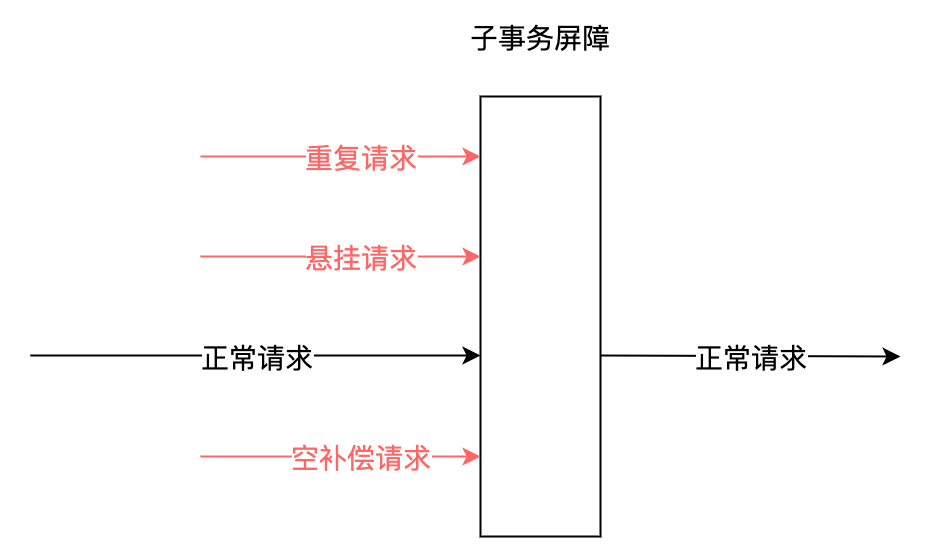
.Net分布式事務及落地解决方案
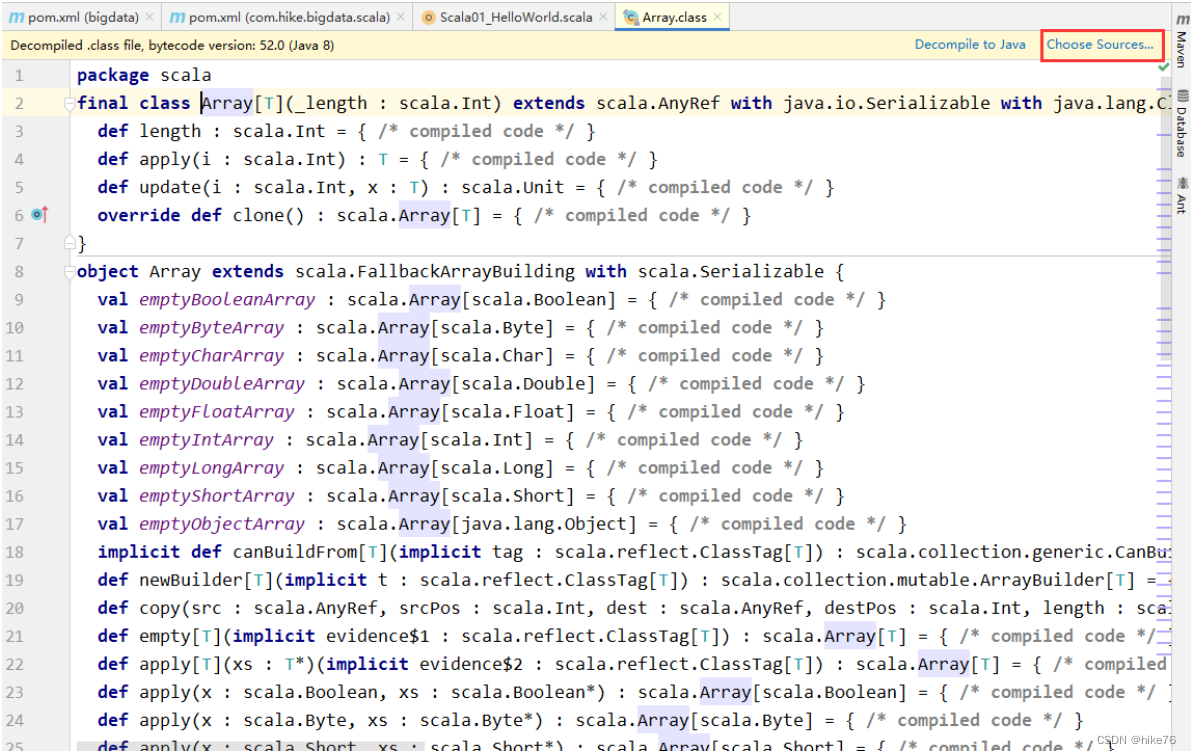
Scala基础【HelloWorld代码解析,变量和标识符】

Debezium series: record the messages parsed by debezium and the solutions after the MariaDB database deletes multiple temporary tables
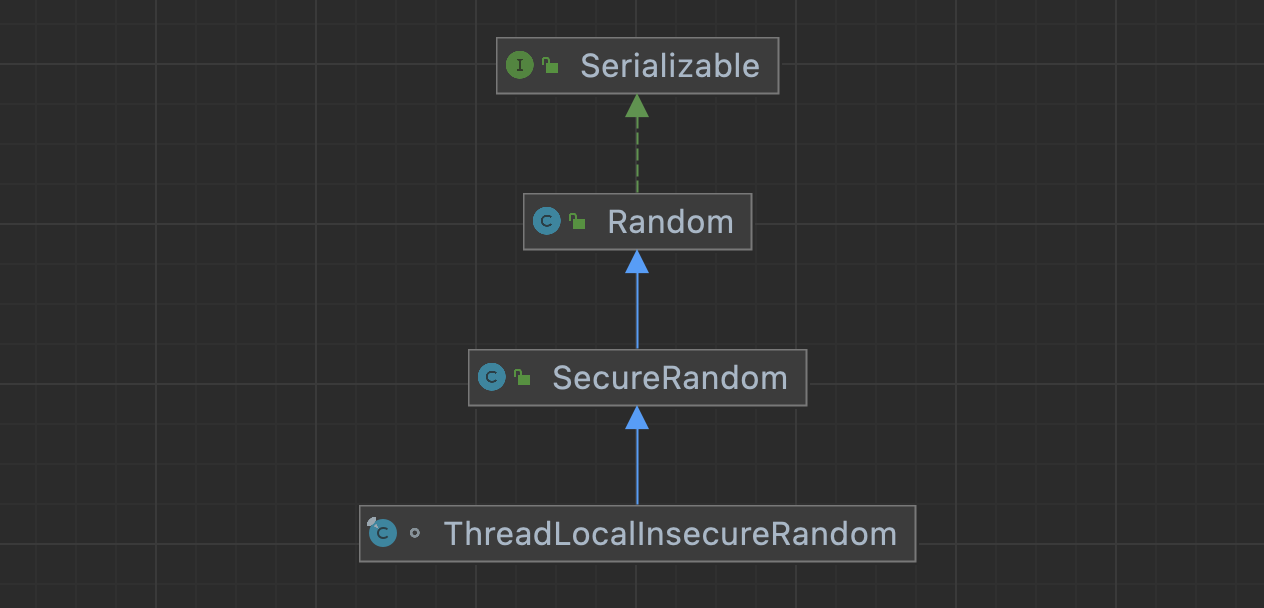
Parler de threadlocal insecurerandom

Build your own website (16)
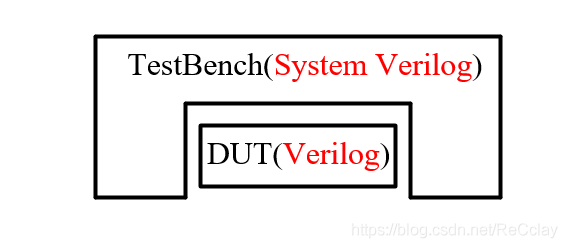
【数字IC验证快速入门】1、浅谈数字IC验证,了解专栏内容,明确学习目标

How to safely and quickly migrate from CentOS to openeuler
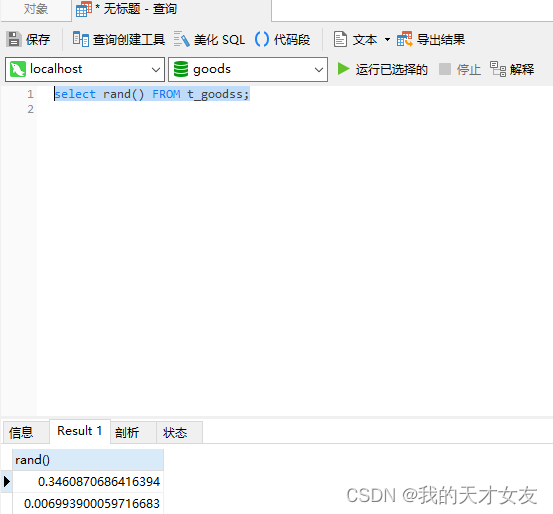
Database logic processing function
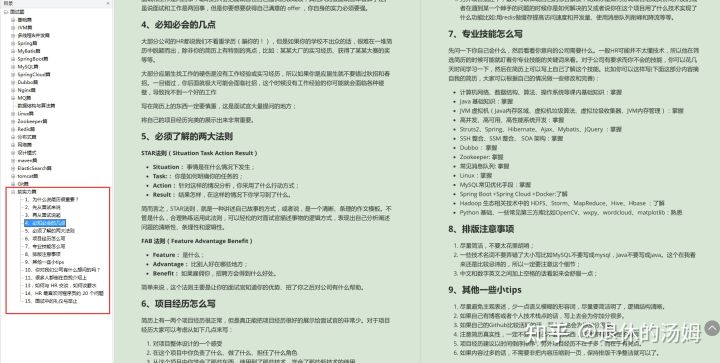
95后阿里P7晒出工资单:狠补了这个,真香...

third-party dynamic library (libcudnn.so) that Paddle depends on is not configured correctl
随机推荐
炒股开户最低佣金,低佣金开户去哪里手机上开户安全吗
After 95, Alibaba P7 published the payroll: it's really fragrant to make up this
怎么挑选好的外盘平台,安全正规的?
解决php无法将string转换为json的办法
Leetcode skimming: binary tree 10 (number of nodes of a complete binary tree)
leetcode刷题:二叉树12(二叉树的所有路径)
Leetcode brush questions: binary tree 18 (largest binary tree)
Float.floatToRawIntBits的返回值具体意思,将float转为byte数组
14. Users, groups, and permissions (14)
Ffplay document [easy to understand]
95后阿里P7晒出工资单:狠补了这个,真香...
How to retrieve the root password of MySQL if you forget it
如何安全快速地从 Centos迁移到openEuler
Cocos2d-x项目总结中的一些遇到的问题
Bitcoinwin (BCW) was invited to attend Hanoi traders fair 2022
What is PyC file
.Net分布式事務及落地解决方案
处理文件和目录名
零道云新UI设计中
[C language] string function and Simulation Implementation strlen & strcpy & strcat & StrCmp